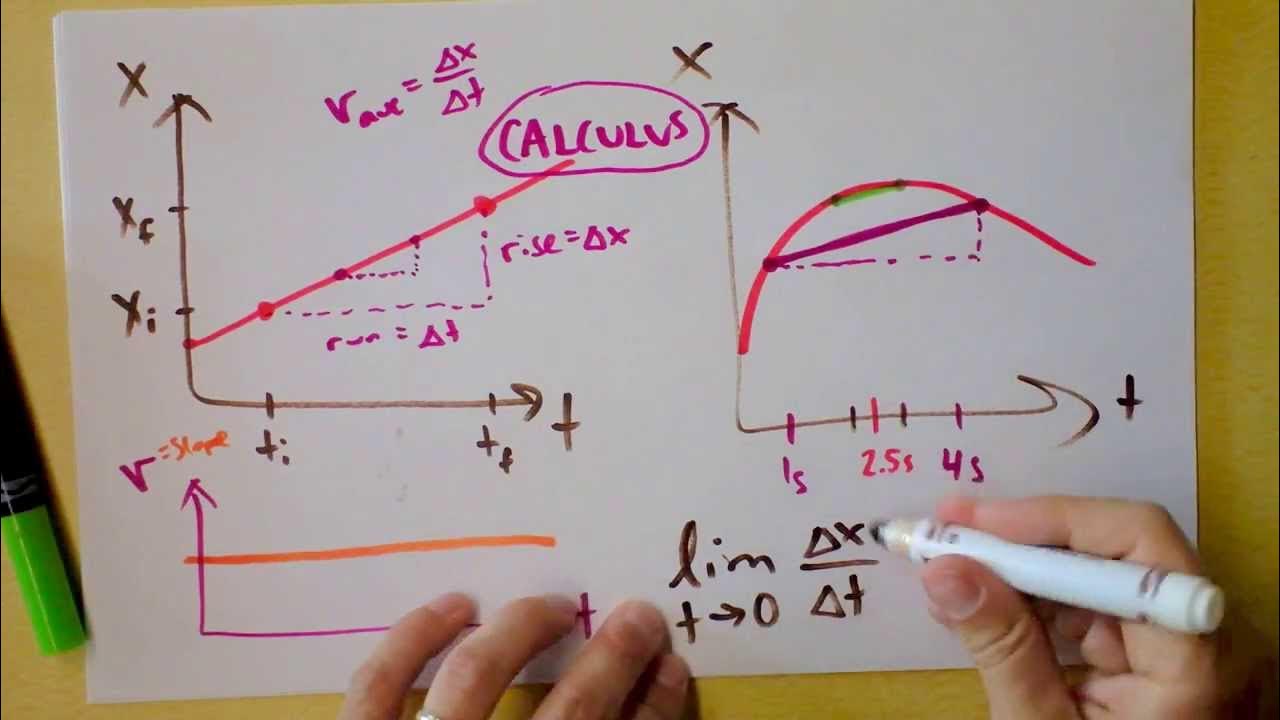Kinematics: Acceleration Vs Time Graph
Summary
TLDRThis educational video script explores the concept of acceleration versus time, illustrating how the area under the graph represents change in velocity. It explains the relationship between acceleration, time, and velocity using mathematical formulas. The script also includes a practical example of a tricycle's motion, calculating its final velocity after 2.0 seconds given an acceleration function. The video aims to clarify the physical principles behind acceleration and velocity changes, making complex physics concepts more accessible.
Takeaways
- 📈 The script discusses the concept of acceleration versus time graphs, explaining how the area under the graph represents change in velocity.
- ⏱️ It introduces the term 'delta t' or change in time, which is a measure of time intervals on the x-axis of the graph.
- 🔢 The area under the graph is likened to the formula for volume, where height times width gives the area, and in this case, average acceleration times change in time gives the change in velocity.
- 🌟 The formula for change in velocity (delta v) is given as 'a times delta t', which is the area under the acceleration-time graph.
- 📚 The script explains the mathematical limit definition of change in velocity as delta t approaches zero, which is the summation of 'a sub i times delta t sub i' from i=1 to n.
- 🧮 It provides a detailed example of calculating final velocity by integrating the acceleration function from the initial time to the final time.
- 🚴♂️ The example involves a tricycle rider named Circus who starts from a position 5.0 meters away from the origin with an acceleration function of '10.0 m/s^2 + 3.0 m/s^4 * t^2'.
- ⏳ The calculation for the rider's velocity after 2.0 seconds is demonstrated, involving the integration of the acceleration function over the time interval.
- 🔍 The anti-derivatives of the acceleration components are calculated, and the limits of integration from 0 to 2.0 seconds are applied to find the velocity.
- 🏁 The final velocity is computed to be 28 meters per second after applying the limits of integration and simplifying the expression.
Q & A
What is the relationship between acceleration and the area under the acceleration versus time graph?
-The area under the acceleration versus time graph represents the change in velocity (Δv), which can be calculated as the integral of acceleration over time.
What does the term 'delta t' signify in the context of the script?
-In the script, 'delta t' refers to the change in time (Δt), which is the difference between the final time and the initial time.
How is the final velocity of an object calculated when given its acceleration as a function of time?
-The final velocity (v) is calculated by adding the initial velocity (v₀) to the integral of acceleration (a(t)) with respect to time from the initial time (t₀) to the final time (t).
What is the formula for calculating the change in velocity when acceleration is constant?
-When acceleration is constant, the change in velocity (Δv) is given by the formula Δv = a * Δt, where 'a' is the constant acceleration and 'Δt' is the change in time.
What does the term 'a sub i' represent in the script?
-The term 'a sub i' likely represents the acceleration at a specific time interval 'i' when acceleration is not constant and varies over time.
How is the integral of acceleration over time related to the change in velocity?
-The integral of acceleration over time is equal to the change in velocity, as acceleration is the rate of change of velocity.
What is the significance of the integral from t₀ to t of 'a of t' with respect to time in the script?
-This integral represents the total change in velocity over the time interval from t₀ to t, given the acceleration as a function of time.
In the example provided, what is the initial displacement of the tricycle?
-The initial displacement of the tricycle is 5.0 meters from its original position.
What is the expression for the acceleration of the tricycle in the example, and how does it change over time?
-The acceleration of the tricycle is given by the expression 10.0 m/s² + 3.0 m/s⁴ * t², which means the acceleration increases quadratically over time.
What is the final velocity of the tricycle after 2.0 seconds, as calculated in the script?
-The final velocity of the tricycle after 2.0 seconds is 28.0 meters per second, calculated by integrating the acceleration function over time and adding it to the initial velocity.
Outlines

Esta sección está disponible solo para usuarios con suscripción. Por favor, mejora tu plan para acceder a esta parte.
Mejorar ahoraMindmap

Esta sección está disponible solo para usuarios con suscripción. Por favor, mejora tu plan para acceder a esta parte.
Mejorar ahoraKeywords

Esta sección está disponible solo para usuarios con suscripción. Por favor, mejora tu plan para acceder a esta parte.
Mejorar ahoraHighlights

Esta sección está disponible solo para usuarios con suscripción. Por favor, mejora tu plan para acceder a esta parte.
Mejorar ahoraTranscripts

Esta sección está disponible solo para usuarios con suscripción. Por favor, mejora tu plan para acceder a esta parte.
Mejorar ahoraVer Más Videos Relacionados

Velocity vs time graphs

GCSE Physics Revision "Acceleration"

Deriving Kinematic Equations - Kinematics - Physics

Instantaneous Velocity, Acceleration, Jerk, Slopes, Graphs vs. Time | Doc Physics

Aprenda a LER um Gráfico de VELOCIDADE X TEMPO | CINEMÁTICA

Integration and the fundamental theorem of calculus | Chapter 8, Essence of calculus
5.0 / 5 (0 votes)
